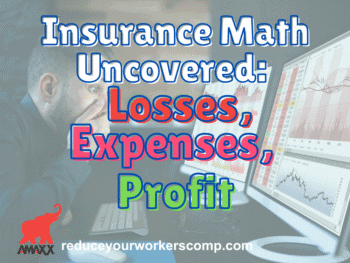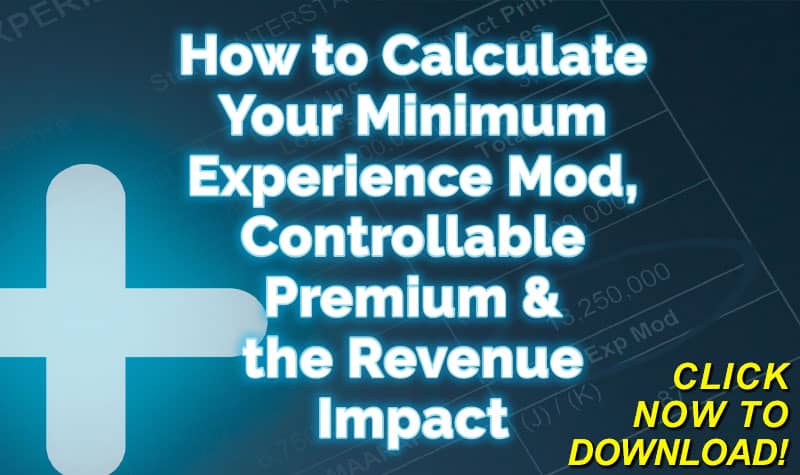1-Your Experience Mod Creeps Over 1.0
Your experience mod number is calculated on the kinds of jobs your employees perform, how many times injuries occur at your work place, multiplied by each one hundred dollars ($100) of your payroll.
The state rate is a key factor in driving your experience mod. So, if employees at your company perform more hazardous jobs, your state rate is higher. If your employees are injured more than employees doing similar jobs at other companies, your state rate is higher. If your state class rate is higher, so is your experience mod.
The higher your experience mod is, the higher your premiums. And, we’re not even talking about indemnity payments. If you have a bad year with several work related injuries, you experience mod is effected for the next three years.
For the short-turn, recalculate your loss runs to ensure they are correct. Separate medical claims from indemnities. Document early claim closures and ensure this is reflected in your loss runs. These steps have a direct impact on your experience mod number!
For the long term, re-emphasize your safety program, but also establish a separate workers’ compensation management program to get injured employees back to work in a modified duty capacity as quickly as possible. Establish a workers’ comp management communication triangle between you, the injured employee, the treating physician and the insurance company.
2-The Safety Person is in Charge of Workers’ Comp Management
If your safety person is also responsible for implementing workers' compensation management, you should make sure a formal workers' compensation management program is established and implemented. This begins with a thorough breakdown in assessment and benchmarking to determine where your company stands relative to similar companies. There are ten cost drivers in workers’ comp, you should know them and identify your strengths and weaknesses in terms of those cost drivers.
Once you have your data together, you should publish your intentions via a workers' comp policy statement, and a program including return-to-work policies and transitional duty. Include a formal communications component to bring employees on board from every work site.
Update your benchmarking via a transitional duty or return to work ratio every month, to see how you’re progressing. Workers’ comp management is an art form unto itself, and merits attention in its own right. You will soon see rewards enough in terms of lower premiums and indemnity payments and higher profit margins.
3-You Hear Management Say, “Data Processing” Will Handle Your Communications Program
Communications is more than typing up brochures and wallet cards. Communications is a well-thought out strategy for bringing your employee audience into the workers’ comp management loop. You must know the state laws for every state you do business in and your communications varies accordingly. You must know the primary languages and reading levels of your target audiences and vary your communications accordingly. You must take very complicated concepts and make them simple so everyone gets the message. Also, you must vary your communication program so your audience can see, hear and read the messages. You must know how to write a policy, dovetail it to program procedures and the take-aways audience members can carry with them after the meetings. All the while making it very, very interesting.
If data processing can do all this, so much the better. But while management is lamenting over their increasing experience mods, premiums, and indemnity payments, they would do well to rethink their attack strategy for implementing a workers’ comp management program able to effectively lower those costs in as little as 90 days.
4-You Have Claims Reports Going to Defunct Work Sites
Get a contact person, and while you’re at it, get the supervisor’s name. Visit the insurer’s office to see the lay of the land. If you see the office is disorganized, then this is a red flag. If you see files lying on the floor, or the adjusters are on different floors or geographically separated by cube walls this sends a message of disorganization.
Review your statements (loss runs) carefully every month to make sure defunct sites are not listed.
5-You Have Employees Out on Comp for Years and You Truly Don’t Know Where They are or What They’re Doing
Communicate with your injured employee from day one. Insist a copy of the work ability form, completed by the treating physician, be faxed to you. Send flowers and a get-well card to the employee. Call every week for an informal telephone meeting, until the employee can come on site for meetings. Create a company-wide expectation stating work related injuries are a temporary setback and employees return to work in a modified duty capacity, while they work toward full duty employment.
Podcast/Webcast: How To Prevent Fraudulent Workers' Compensation Claims
Click Here http://www.workerscompkit.com/gallagher/podcast/
Fraudulent_Workers_Compensation_Claims/index.php
FREE WC IQ Test: http://www.workerscompkit.com/intro/
TD Calculator: www.reduceyourworkerscomp.com/transitional-duty-cost-calculator.php
Do not use this information without independent verification. All state laws vary. You should consult with your insurance broker or agent about workers' comp issues.


















